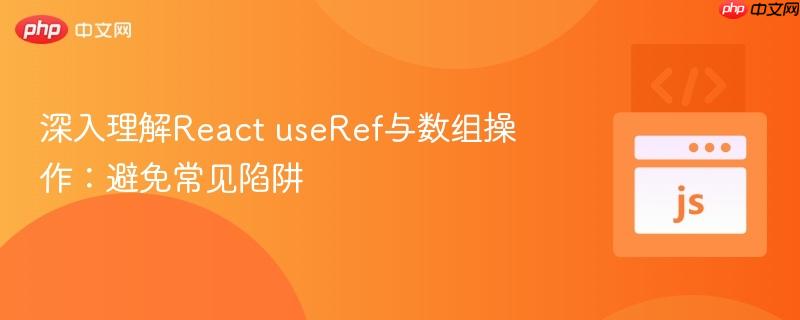
在使用react的`useref`管理非渲染数据时,对存储在其中的数组进行过滤操作是一个常见场景。本文将详细阐述为何`array.prototype.filter()`方法无法直接修改`useref`中存储的数组,并提供正确的更新策略,同时纠正了访问`useref`长度的常见错误,确保数据管理和逻辑判断的准确性。
在React应用中,useRef是一个非常有用的Hook,它允许我们在组件的整个生命周期中持久化一个可变的值,而不会触发组件的重新渲染。这使得它非常适合存储不直接影响UI的数据,例如DOM元素的引用、计时器ID或者本例中讨论的非渲染数据数组。
然而,当我们在useRef中存储一个数组并尝试对其进行修改时,一个常见的误解是认为像filter()这样的数组方法会原地修改原始数组。实际上,JavaScript中的许多数组方法,包括filter()、map()、slice()等,都是不可变的。这意味着它们不会修改调用它们的原始数组,而是返回一个包含新结果的新数组。
考虑以下代码片段,它试图从useRef中存储的items.current数组中移除一个元素:
let items = useRef([]); // 假设 items.current 已经包含一个数组 // ... // 尝试过滤掉名为 'toy' 的项目 items.current.filter((item) => item.name !== toy); // 此时,items.current 并没有被修改!
这段代码的问题在于,filter()方法执行后,会返回一个不包含指定toy的新数组,但这个新数组并没有被赋值回items.current。因此,items.current仍然保持着过滤前的原始数组。
要正确地更新useRef中存储的数组,我们需要将filter()方法返回的新数组显式地赋值回items.current。
import { useNavigate } from 'react-router-dom';
import { useState, useEffect, useRef } from "react";
import supabase from "../config/supabaseClient";
import Image from "./image";
import Timer from "./timer";
const Game = () => {
let items = useRef([]); // 使用 useRef 存储非渲染数据
const [fetchError, setFetchError] = useState(null);
const [found, setFound] = useState("");
const [time, setTime] = useState(0);
const navigate = useNavigate();
useEffect(() => {
const fetchOptions = async () => {
const { data, error } = await supabase
.from('items')
.select();
if (error) {
setFetchError('Could not fetch items');
items.current = [];
}
if (data) {
items.current = data;
setFetchError(null);
}
}
fetchOptions();
}, []);
function handleAction(click, toy) {
const item = items.current.find(item => item.name === toy);
if (!item) {
setFound(`Not quite, try again!`);
return;
}
if (click.x > item.left && click.x < item.right) {
if (click.y < item.bottom && click.y > item.top) {
setFound(`Well done! You've found Sarah's ${toy}`);
// 正确的做法:将过滤后的新数组重新赋值给 items.current
items.current = items.current.filter((i) => i.name !== toy);
console.log("Updated items.current:", items.current); // 检查更新后的数组
// 检查数组长度时,也需要访问 items.current
if (items.current.length === 0) {
console.log('Winner');
navigate("/leaderboard", { state: time });
}
}
} else {
setFound(`Not quite, try again!`);
return;
}
}
return (
<>
{fetchError && (<p>{fetchError}</p>)}
<Timer time={time} setTime={setTime} />
<Image handleAction={handleAction} />
<p>{found}</p>
</>
);
}
export default Game;在上述代码中,关键的修改是这一行:
items.current = items.current.filter((i) => i.name !== toy);
通过将filter()方法返回的新数组赋值回items.current,我们确保了useRef中存储的数据得到了正确的更新。
除了过滤操作,另一个与useRef相关的常见错误是直接访问ref对象的length属性,而不是其current属性的length。
错误的示例:
if (items.length === 0) { // 错误!items 是一个 ref 对象,不是数组
console.log('Winner');
navigate("/leaderboard", { state: time });
}items本身是一个RefObject,它不具备length属性(除非你把它赋值为一个带有length属性的对象,但这与我们的意图不符)。我们真正想要检查的是useRef所引用的数组的长度,因此必须通过items.current来访问。
正确的做法:
if (items.current.length === 0) { // 正确!访问 ref 引用值的长度
console.log('Winner');
navigate("/leaderboard", { state: time });
}通过理解这些核心概念和避免常见陷阱,您可以更有效地在React应用中使用useRef来管理复杂的数据结构。
以上就是深入理解React useRef与数组操作:避免常见陷阱的详细内容,更多请关注php中文网其它相关文章!

每个人都需要一台速度更快、更稳定的 PC。随着时间的推移,垃圾文件、旧注册表数据和不必要的后台进程会占用资源并降低性能。幸运的是,许多工具可以让 Windows 保持平稳运行。

Copyright 2014-2025 https://www.php.cn/ All Rights Reserved | php.cn | 湘ICP备2023035733号